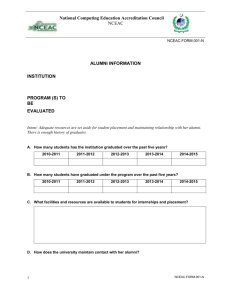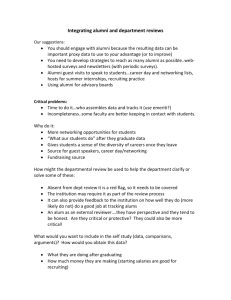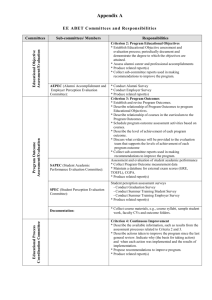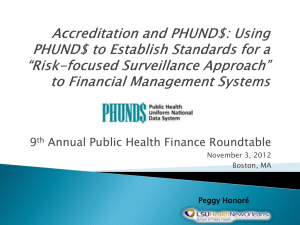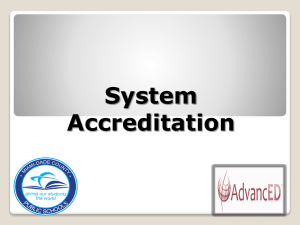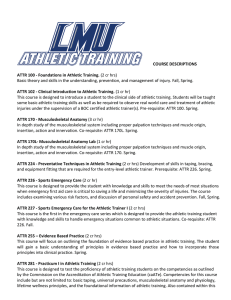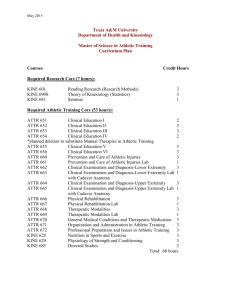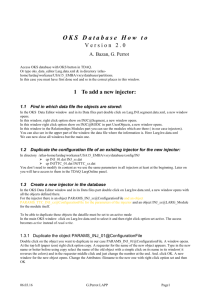2007 and 2008 - Western Carolina University
advertisement
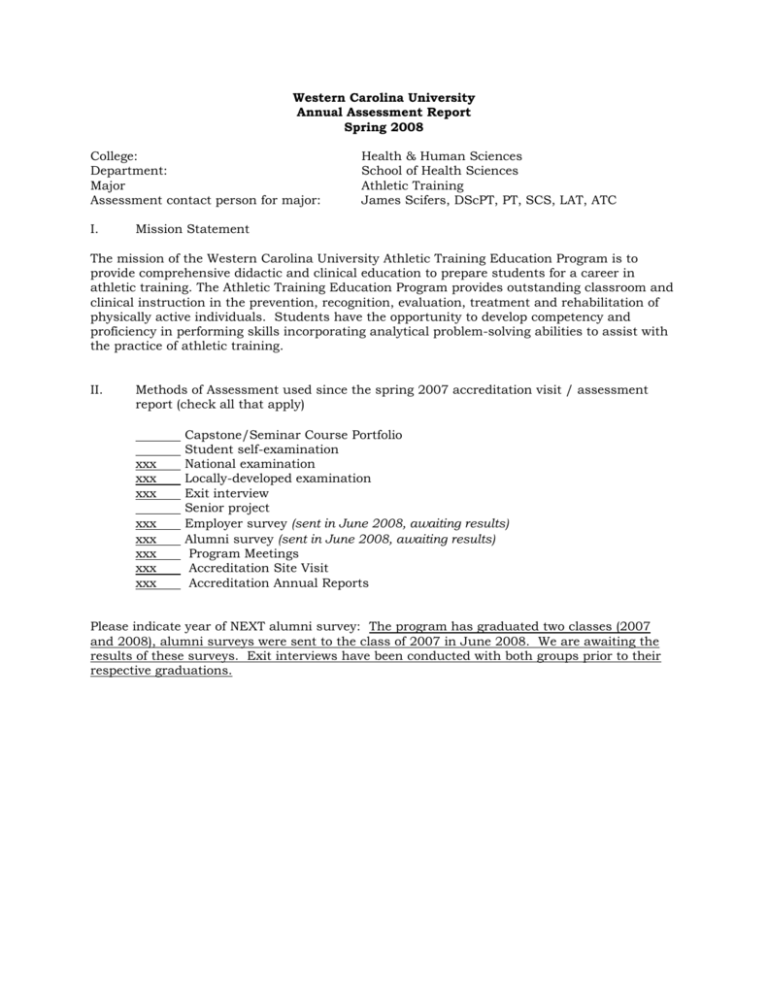
Western Carolina University Annual Assessment Report Spring 2008 College: Department: Major Assessment contact person for major: I. Health & Human Sciences School of Health Sciences Athletic Training James Scifers, DScPT, PT, SCS, LAT, ATC Mission Statement The mission of the Western Carolina University Athletic Training Education Program is to provide comprehensive didactic and clinical education to prepare students for a career in athletic training. The Athletic Training Education Program provides outstanding classroom and clinical instruction in the prevention, recognition, evaluation, treatment and rehabilitation of physically active individuals. Students have the opportunity to develop competency and proficiency in performing skills incorporating analytical problem-solving abilities to assist with the practice of athletic training. II. Methods of Assessment used since the spring 2007 accreditation visit / assessment report (check all that apply) xxx xxx xxx xxx xxx xxx xxx xxx Capstone/Seminar Course Portfolio Student self-examination National examination Locally-developed examination Exit interview Senior project Employer survey (sent in June 2008, awaiting results) Alumni survey (sent in June 2008, awaiting results) Program Meetings Accreditation Site Visit Accreditation Annual Reports Please indicate year of NEXT alumni survey: The program has graduated two classes (2007 and 2008), alumni surveys were sent to the class of 2007 in June 2008. We are awaiting the results of these surveys. Exit interviews have been conducted with both groups prior to their respective graduations. III. Program Goals Goal 1. Provide students with a learning environment that offers the student the cognitive, behavioral, and psychomotor skills necessary for successful entry-level practice as an athletic trainer. (All ATTR courses, HSCC 150, HSCC 240/241, HSCC 370, ND 320, PE 425) Objective 1.1. Upon completion of the program, the student will demonstrate the ability to comprehend, apply and evaluate the clinical information relative to his/her role as an entry-level athletic trainer. (Assessment tools include evaluations in relevant courses, Board of Certification Exam results, locally-developed competency examinations, alumni and employer surveys) Objective 1.2. Upon completion of the program, the student will demonstrate technical proficiency in all skills necessary to fulfill the role of an entry-level athletic trainer. (Assessment tools include evaluations in relevant courses, Board of Certification Exam results, locally-developed competency examinations, alumni and employer surveys) Objective 1.3. Upon completion of the program, the student will demonstrate personal behaviors consistent with professional and employment expectations for the entry-level athletic trainer. (Assessment tools include clinical instructor evaluations alumni and employer surveys) Goal 2. Provide students the ability to apply leadership and decision-making skills to include ethics, group dynamics, management of human behavior, teambuilding and professional conduct. (ATTR 283, ATTR 284, ATTR 383, ATTR 384, ATTR 483, ATTR 484, ATTR 410, ATTR 415, HSCC 150, clinical instructor evaluations, alumni and employer surveys) Goal 3. Provide students the ability to understand the administrative functions of health care managers including, budgets, finance, strategic planning, risk management, legal environment of health care, principles of supervision, cost control, and revenue and cost forecasting. (ATTR 410, ATTR 415, HSCC 150) (Assessment tools include evaluations in relevant courses, alumni and employer surveys) Goal 4. Promote the importance of research and provide the tools for understanding basic research and evaluation techniques. Students will become proficient in locating, reading, and interpreting medical literature. Students will develop skill in planning and conducting research in athletic training, including research design and statistical analysis. (ATTR 410 and ATTR 415) (Assessment tools include evaluations in relevant courses, alumni and employer surveys) Goal 5. Students will be able to effectively communicate via oral and written means, including computer presentations and documentation in medical records. (All ATTR courses) (Assessment tools include evaluations in relevant courses, alumni and employer surveys.) IV. Assessment Tools 2007 Accreditation Site Visit Annual Accreditation Reports Written examinations in courses Practical examinations in courses Written, practical and written simulation competency examinations at the conclusion of each semester in the program after formal admission Student evaluations of course and faculty effectiveness Spring 2007 Accreditation Site Visit Clinical instructor evaluations Surveys of employers (awaiting results of surveys sent in June 2008) Exit interviews of seniors (2007 and 2008) One-year follow-up surveys of graduates (awaiting results of surveys sent in June 2008) Board of Certification Examination Results Review of Recommendations of Athletic Training Advisory Board V. Use of Outcomes Assessment VI. Certifying exam results are made available to all faculty members in the program Results of program meetings, exit interviews, one-year follow-up surveys, and employer surveys are made available to all program faculty, with program changes implemented as needed. Individual instructors will take measures to remedy any deficiencies identified by certifying exams, course evaluations, exit interviews or employer surveys. Program faculty will take measures to strengthen the program based on the recommendations of the 2007 accreditation site visit and the 2008 annual accreditation reports. Spring 2007 Assessment Findings The initial accreditation site visit in 2007 identified only minor areas of concern for the program. Each of the site visit team’s concerns were easily addressed by program faculty in the accreditation rejoinder. The program was granted initial accreditation in July 2007. The 2008 annual report, sent to the Commission on Accreditation of Athletic Training Education (CAATE) in May 2008 indicated no areas of program deficiency with regard to accreditation. The results of the 2007 and 2008 Board of Certification (BOC) Exams are shown below. Graduating Class Students BOC First Time Pass (%) Total BOC Pass (%) Class of 2007 12 7 (58%) 11 (92%) Class of 2008 7 (May Graduates) 5 (71%) 5 (71%) PROGRAM TOTALS 19 12 (63%) 16 (84%) VII. Program Changes The following changes have been made for the 2007-2008 academic year based on the program’s initial site visit. The university catalog and the athletic training education program website have been updated (and continue to be updated) to accurately reflect program practices. Course syllabi for supporting courses in emergency medical care, nutrition, pharmacology and exercise physiology are being reviewed and updated to continue to meet accreditation standards. The number of athletic training faculty has been increased from 2 full-time positions to 2.5 positions for the 2008-2009 academic year. This change was accomplished by adding an additional full-time tenure track position in Athletic Training and losing 50% of the position occupied by Dr. Scifers when he assumed the role of Associate Dean for the College of Health & Human Sciences. The program does nave the opportunity to utilize adjunct faculty to teach the remainder of Dr. Scifers teaching load. Adjuncts will be utilized to teach 5 credits in the Fall 2008 semester and 2-5 credits in the Spring 2009 semester depending on enrollment patterns.
